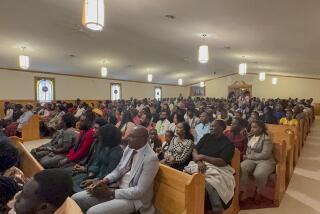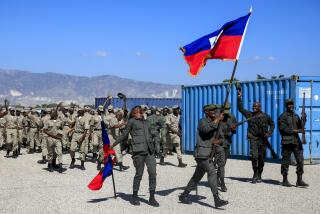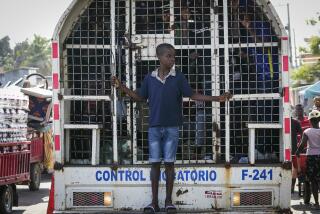Haitian Haven Sees Strife as Opportunity
JACMEL, Haiti — The quaint, two-story villas with filigreed verandas may need a lick of paint, and the relentless din of motorbikes and dump trucks along the main thoroughfare is hardly conducive to a laid-back Caribbean vacation.
But otherwise, this picturesque seaside resort known for cheerful handcrafts and spring festivals testifies to the potential that Haiti has seldom lived up to. An oasis of calm with a vibrant, can-do spirit, Jacmel is a glaring exception to the national legacy of opportunity lost to outbreaks of violence.
United in a drive to market their town of 30,000 as Haiti’s cultural capital and premier tourist destination, Jacmel’s residents managed to head off most of the looting and vandalism that ravaged large parts of the country in recent months as a rebellion drove President Jean-Bertrand Aristide into exile.
Jacmel’s business leaders kept the people focused on the common good with radio broadcasts urging tolerance and respect for their neighbors’ property as well as political positions.
“Only the police station was ransacked, and people even brought back some of what they took from there after appeals went out on the radio,” said Marie Giselaine Michel, director of the Aid to Artisans project, which promotes local crafts.
The newly constituted Group for Reflection and Political Observation has enlisted youths to paint over pro-Aristide graffiti and spruce up the central streets in anticipation of tourism.
Although Jacmel’s main streets are potholed and sidewalks are obstacle courses of broken concrete, they are largely free of the sewage and sludge-coated debris found in many parts of the capital, Port-au-Prince, a two-hour drive to the northeast.
But with more than 300 deaths since rebels rose up against Aristide on Feb. 5, the only foreign visitors to Haiti these days are U.S., French, Canadian and Chilean peacekeepers and a small contingent of relief workers.
“Right now we can’t talk about tourism. First we have to focus on the country’s image,” said Danielle St. Lot, whose duties as interim minister for commerce and industry include the stillborn sphere of tourism. She reckons it will take at least a year for the scenes of machete-wielding looters and gunmen to fade from the memories of potential visitors.
Jacmel’s boosters are more optimistic. “Many countries have had violent events, but with time people forget,” said Michaelle Craan, an artist employed by the local chamber of commerce.
Jacmel’s civic leaders are working on development plans that seek to tune out the troubled country beyond the town limits. By building a charter airfield and expanding the marina, they would like to spare visitors the squalor of Port-au-Prince, whose La Saline and Carrefour slums flank the only road leading from the capital’s international airport to Jacmel.
Such improvements, they hope, will bring prosperity anew to Jacmel, which had a late 19th century heyday as a bustling coffee port and was the first Haitian town to get telephones and electricity. Jacmel’s lush tropical foliage, year-round sunshine and proximity to other vital stops on the West Indies trade route enticed French merchants to move their homes piece by piece across the ocean on the ships that returned with Haiti’s bounty of coffee, bananas, spices and essential oils that Paris needed for its perfume industry.
In more recent decades, Jacmel became a tourist destination, attracting more than 100,000 visitors some years to its Carnival and May Day festivities.
But with tourism now having all but evaporated, local artisans who fashion tableware from palm fronds, gourds and plywood survive on sales to foreign vendors and Web-based catalog companies, said Thomas Oriental, a local designer.
They are also busy building displays for Broadway shows, backdrops for the San Diego Zoo and a Haitian exhibit that will open in June at the Smithsonian Institution, added Michel, of the Artisans project.
Many here attribute Jacmel’s stability amid the recent unrest to the cultural establishment that holds sway in the town, where more than 10% of the population is employed in crafts. Jacmel also enjoys a tranquil religious environment in which adherents of the Catholicism bequeathed by French colonialists, African voodoo and the Bahai faith brought by missionaries share a common social vision.
During the height of the political chaos in early March, Msgr. Guire Poulard urged Jacmel residents to keep in mind that looting and pillaging harmed Haiti’s people, not its politicians.
“He admonished people not to loot, and the radio stations played some tapes my wife prepared about unity, prayer and nonviolence. It had a very soothing effect on the population,” said Moro Baruk, a Bahai who came from Arizona with his Algerian-born wife, Paule, 25 years ago.
Having survived the strife, Jacmel is focused on its ambitious comeback plans. Not only do local boosters expect to see visitors flock back for Carnival and May Day, they have also been negotiating with a major Miami-based cruise ship company to convert a pier to accommodate passenger visits. And they are casting about for a sponsor for a late-summer jazz festival.
Eco-tourism is another prospect, as Jacmel is situated in a part of Haiti that is untouched by erosion and deforestation. Seventy homeowners have banded together to form a bed-and-breakfast association with the aim of renting spare rooms to visitors seeking a closer experience with Haitian culture.
Two busy streets that parallel Jacmel’s waterfront, Rue du Commerce and Rue St. Anne, are destined to be closed to traffic to create a pedestrian art market. The town’s main park outside the port offices will be renamed Pan-American Square and feature a museum highlighting the local exploits of Latin American independence hero Simon Bolivar, Craan said.
In the meantime, locals are looking forward to the arrival of international peacekeepers, who are seen as good for business as well as security. The troops, though, have chosen to focus on more troubled areas of Haiti first, to the disappointment of many local merchants.
“They will add to the image of stability, and they have to eat somewhere!” Gael Perpignand, owner of a terrace restaurant called Ambience, said in eager anticipation.
At the Cap Lamandou Hotel, a cheery, peach-colored seafront complex that opened less than four months ago, receptionist Cheamy Jean-Philippe said occupancy went from an inaugural sellout at Christmas to a crisis-era zero, but it has lately been in an upswing.
“Most of our clients come from Port-au-Prince, where there is still a lot of tension,” she said. “They know it’s safe here, but they don’t yet know if what they leave behind will be safe in their absence.”
More to Read
Sign up for The Wild
We’ll help you find the best places to hike, bike and run, as well as the perfect silent spots for meditation and yoga.
You may occasionally receive promotional content from the Los Angeles Times.







